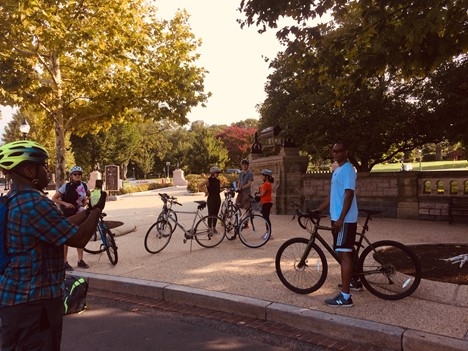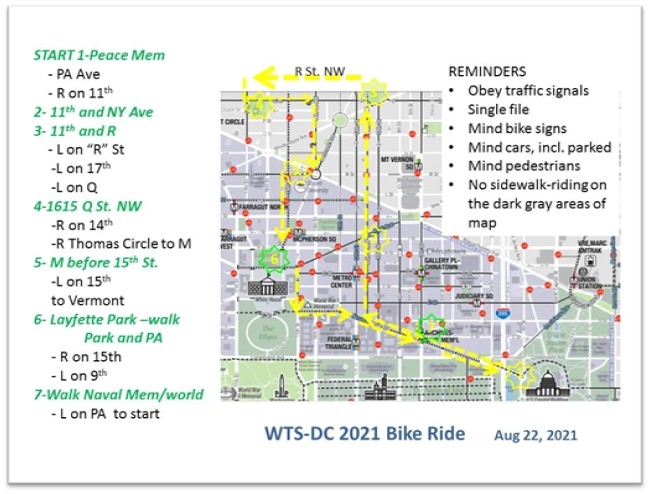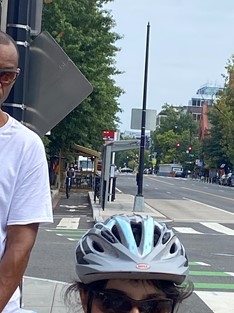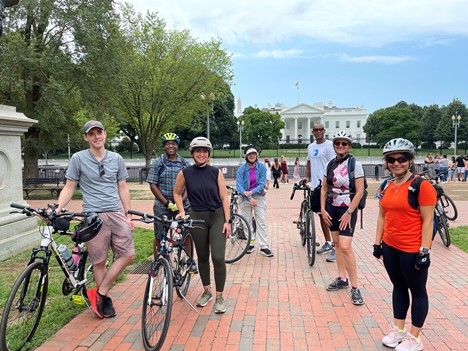7th Annual WTS-DC Bike Tour
By Cerasela Cristei, WTS-DC
September 2021
Bicycle infrastructure in the Washington, D.C. metropolitan area is making the streets safer, one bike lane at a time. This year we held an informative virtual event in April, and we received several requests for an in-person bike tour.

A small group met on a cloudy but warm morning in front of the Capitol building and embarked on an approximately 5-mile bike ride. After introductions, and a safety discussion and equipment check, the “magnificent seven” left the Capitol and took the cycle track on Pennsylvania Avenue toward 11th Street. Margaret Ballard, WTS-DC advisor, was our expert tour guide who peppered the tour with historical facts.
What are Complete Streets and Great Streets?
Complete streets are designed and operated to be safe and accessible for all modes of transportation and abilities. Not every street requires bike lanes or transit stops to be complete, but every complete street accommodates pedestrians of varying age and ability safely and comfortably. Great Streets is the District’s commercial revitalization initiative, led by the Office of the Deputy Mayor for Planning and Economic Development (DMPED), designed to support existing small businesses, attract new businesses, increase the District’s tax base, create new job opportunities for residents, and transform emerging corridors into thriving and inviting neighborhood centers. Great Streets are expanded versions of complete streets, and include multimodal travel, streetscape enhancements and environmental stormwater measures.
Benefits of Complete and Great Streets:
- Safety – reduced pedestrian and cyclist fatalities
- Livability – accessible streets improve sense of community and street activity
- Health – walking and cycling lead to better health outcomes (higher levels of fitness through routine daily activity)
- Economic – increased pedestrian and cycling traffic on urban streets are associated with retained spending and higher property values
Characteristics of a Great Street include:
- Provides orientation to its users, and connects well to the larger pattern of ways.
- Balances the competing needs of the street—driving, transit, walking, cycling, servicing, parking, drop-offs, etc.
- Fits the topography and capitalizes on natural features.
- Is lined with a variety of interesting activities and uses that create a varied streetscape.
- Has urban design or architectural features that are exemplary in design.
- Relates well to its bordering uses—allows for continuous activity, doesn't displace pedestrians to provide access to bordering uses.
- Encourages human contact and social activities.
- Employs hardscape and/or landscape to great effect.
- Promotes safety of pedestrians and vehicles and promotes use over the 24-hour day.
- Promotes sustainability through minimizing runoff, reusing water, ensuring groundwater quality, minimizing heat islands, and responding to climatic demands.
- Is well maintained, and capable of being maintained without excessive costs.
- Has a memorable character.
The Tour Route


The tour route was designed to incorporate various complete street elements:
- Bicycle infrastructure – road diet, bike lanes, protected bike lanes (cycle tracks), contra-flow travel, sharrow, bike box, green zone
- Pedestrian infrastructure – wide sidewalks, patterned crosswalks, refuge islands, ped-activated signals
- Transit infrastructure – shelters, accessibility
- Vehicle infrastructure – signage, reverse angle parking
- Environmental enhancements – street trees, stormwater planters
- Floating bus stops
The District Department of Transportation (DDOT) implemented a complete streets policy in October 2010, which required DDOT to consider additional modes of transportation in design, construction, and maintenance of its streets. By 2014, DDOT had completed 69 miles of bike lanes! Data collection and level of service measurements are now used to verify project performance, and many complete streets include environmental enhancements such as tree space and green infrastructure.

Pennsylvania Avenue Cycle Track
Pennsylvania Avenue is a great example of complete street. The street has multiple traffic lanes for personal vehicles and buses, a protected two-way bike lane (cycle track) for two-way cyclist traffic, parking lanes on the right, and wide tree-lined sidewalks for pedestrians on both sides. While most were familiar with the Pennsylvania Avenue cycletrack, not everyone knew that it went through multiple design iterations to bring it to the level of safety it now offers to riders of all levels of experience.
The group noticed the turning lanes and how the bike traffic flow is organized to keep everyone moving safely. The tour group benefited from a "talk stop" about it, and even so, sometimes were startled with on-coming bike traffic. Other innovative bike provisions similarly were critiqued at "talk stops" by the group.
- Buffered bike lanes were installed in the center median of the Pennsylvania cycle track in June 2010.
- Bicycle lanes are five feet wide with three-foot buffers on each side.
- At intersections, the approaching bicycle lane splits to provide a turn lane and a through lane. Turning bicyclists wait in the middle (between the through bicycle lanes) while through cyclists follow the traffic signal for through motorists.
- To complete turning movements, cyclists wait for the pedestrian signal and cross in the crosswalk.

15th Street Cycle Track/Separate Bike Lanes
15th Street, running between Pennsylvania Avenue and V Street, was selected as a suitable location to pioneer and experiment with the capital’s first protected bike facility on account of its extra roadway capacity and central location. In 2010, the city installed a one-way southbound, protected contra-flow cycle track. After observing cyclists using the protected facility in both directions, the route was converted to a two-way cycle track. The bikeway is separated from the road by a floating parking lane, buffer, and intermittent yellow plastic pylons. A bicycle signal was also put in place at the intersection with Pennsylvania Avenue to ease the passage of crossing cyclists. According to a 2010 follow-up study by DDOT, the cycle track has increased levels of cycling, decreased riding on the sidewalk, and diminished the number of vehicles per day.
The various bicycle facilities in the city are excellent examples of facilities well designed and well-constructed.
References